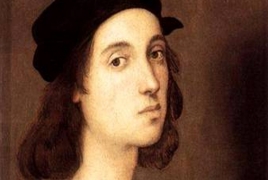
Italian researchers have created a 3D reconstruction of the face of Renaissance master Raphael, which they say proves once and for all that the artist was buried in the Pantheon in Rome.
But scientists made another, more surprising discovery -- they think the artist, who lived from 1483 to 1520, gave himself a "nose job" when painting self-portraits, using some artistic license to "refine" his image in the works, CNN reports.
Researchers from the Tor Vergata University of Rome, along with experts from the Vigamus Foundation and the Accademia Raffaello in Urbino, created a 3D computerized reconstruction of the master's face to find out once and for all whether remains from Rome's Pantheon belonged to Raphael.

In 1833, remains were exhumed from Raphael's grave in the Pantheon, but experts couldn't say for sure whether they belonged to the man himself -- the excavation also uncovered the remains of Raphael's students, as well as some incomplete skeletons.
Creating a 3D render using a plaster cast taken from a skull after the tomb's excavation, scientists then compared the reconstruction with the artist's self portraits, and paintings by others.
As a result, they said they were able to show that the skeleton exhumed in the 1833 dig did indeed belong to the master. From this, came the revelation about the late master's nose.
"The nose that emerged from our reconstruction of the face is certainly more prominent than what appears in Raphael's self-portraits. We therefore think that it is true that Raphael embellished himself, refined himself in his portraits," Mattia Falconi, professor of molecular biology at the Tor Vergata University of Rome, said.
"In his pictorial vision, in his paintings, Raphael represented the beauty of people. Suffice it to see as an example the portrait of Pope Leo X, who certainly was not physically graceful," Falconi added. "Raphael manages to extract beauty," he said.

